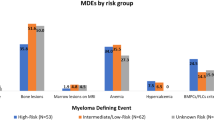Abstract
Previous studies demonstrated the relevance of focal lesions (FL) in whole-body magnetic resonance imaging (wb-MRI) at the initial workup of patients with smoldering multiple myeloma (SMM). The aim of this study was to assess the effects of longitudinal wb-MRIs on progression into multiple myeloma (MM). Sixty-three patients with SMM were analyzed who received at least two wb-MRIs for follow-up before progression into MM. Radiological progressive disease (MRI-PD) was defined as detection of new FL or increase in diameter of existing FL and a novel or progressive diffuse infiltration. Radiological stable disease (MRI-SD) was defined by no change compared with the prior MRI. Patients were followed-up every 3–6 months, including a serological and clinical evaluation. One Hundred and eighty-two wb-MRIs were analyzed. MRI-PD occurred in 31 patients (49%), and 25 (40%) patients developed MM. MRI-PD was highly significantly associated with progression into MM, regardless of findings at the initial MRI. In multivariate analysis, MRI-PD remained a risk factor, independent of relevant baseline parameters like serum monoclonal protein or ⩾95% aberrant plasma cells in the bone marrow. Patients with MRI-SD had no higher risk of progression, even when FL were present at the initial MRI. Therefore, MRI is suitable for the follow-up of patients with SMM.
This is a preview of subscription content, access via your institution
Access options
Subscribe to this journal
Receive 12 print issues and online access
$259.00 per year
only $21.58 per issue
Buy this article
- Purchase on Springer Link
- Instant access to full article PDF
Prices may be subject to local taxes which are calculated during checkout


Similar content being viewed by others
References
Kyle RA, Durie BG, Rajkumar SV, Landgren O, Blade J, Merlini G et al. Monoclonal gammopathy of undetermined significance (MGUS) and smoldering (asymptomatic) multiple myeloma: IMWG consensus perspectives risk factors for progression and guidelines for monitoring and management. Leukemia 2010; 24: 1121–1127.
Kyle RA, Remstein ED, Therneau TM, Dispenzieri A, Kurtin PJ, Hodnefield JM et al. Clinical course and prognosis of smoldering (asymptomatic) multiple myeloma. N Engl J Med 2007; 356: 2582–2590.
Dispenzieri A, Kyle RA, Katzmann JA, Therneau TM, Larson D, Benson J et al. Immunoglobulin free light chain ratio is an independent risk factor for progression of smoldering (asymptomatic) multiple myeloma. Blood 2008; 111: 785–789.
Perez-Persona E, Vidriales MB, Mateo G, Garcia-Sanz R, Mateos MV, de Coca AG et al. New criteria to identify risk of progression in monoclonal gammopathy of uncertain significance and smoldering multiple myeloma based on multiparameter flow cytometry analysis of bone marrow plasma cells. Blood 2007; 110: 2586–2592.
Blade J, Dimopoulos M, Rosinol L, Rajkumar SV, Kyle RA . Smoldering (asymptomatic) multiple myeloma: current diagnostic criteria, new predictors of outcome, and follow-up recommendations. J Clin Oncol 2010; 28: 690–697.
Korde N, Kristinsson SY, Landgren O . Monoclonal gammopathy of undetermined significance (MGUS) and smoldering multiple myeloma (SMM): novel biological insights and development of early treatment strategies. Blood 2011; 117: 5573–5581.
Mariette X, Zagdanski AM, Guermazi A, Bergot C, Arnould A, Frija J et al. Prognostic value of vertebral lesions detected by magnetic resonance imaging in patients with stage I multiple myeloma. Br J Haematol 1999; 104: 723–729.
Moulopoulos LA, Dimopoulos MA, Smith TL, Weber DM, Delasalle KB, Libshitz HI et al. Prognostic significance of magnetic resonance imaging in patients with asymptomatic multiple myeloma. J Clin Oncol 1995; 13: 251–256.
Baur-Melnyk A, Buhmann S, Durr HR, Reiser M . Role of MRI for the diagnosis and prognosis of multiple myeloma. Eur J Radiol 2005; 55: 56–63.
Hillengass J, Fechtner K, Weber MA, Bauerle T, Ayyaz S, Heiss C et al. Prognostic significance of focal lesions in whole-body magnetic resonance imaging in patients with asymptomatic multiple myeloma. J Clin Oncol 2010; 28: 1606–1610.
Bauerle T, Hillengass J, Fechtner K, Zechmann CM, Grenacher L, Moehler TM et al. Multiple myeloma and monoclonal gammopathy of undetermined significance: importance of whole-body versus spinal MR imaging. Radiology 2009; 252: 477–485.
Neben K, Jauch A, Hielscher T, Hillengass J, Lehners N, Seckinger A et al. Progression in smoldering myeloma is independently determined by the chromosomal abnormalities del(17p), t(4;14), gain 1q, hyperdiploidy, and tumor load. J Clin Oncol 2013; 31: 4325–4332.
Simon R, Makuch RW . A non-parametric graphical representation of the relationship between survival and the occurrence of an event: application to responder versus non-responder bias. Stat Med 1984; 3: 35–44.
Dimopoulos M, Terpos E, Comenzo RL, Tosi P, Beksac M, Sezer O et al. International myeloma working group consensus statement and guidelines regarding the current role of imaging techniques in the diagnosis and monitoring of multiple myeloma. Leukemia 2009; 23: 1545–1556.
Walker R, Barlogie B, Haessler J, Tricot G, Anaissie E, Shaughnessy JD Jr. et al. Magnetic resonance imaging in multiple myeloma: diagnostic and clinical implications. J Clin Oncol 2007; 25: 1121–1128.
Hillengass J, Ayyaz S, Kilk K, Weber MA, Hielscher T, Shah R et al. Changes in magnetic resonance imaging before and after autologous stem cell transplantation correlate with response and survival in multiple myeloma. Haematologica 2012; 97: 1757–1760.
Rajkumar SV, Gupta V, Fonseca R, Dispenzieri A, Gonsalves WI, Larson D et al. Impact of primary molecular cytogenetic abnormalities and risk of progression in smoldering multiple myeloma. Leukemia 2013; 27: 1738–1744.
Rosinol L, Blade J, Esteve J, Aymerich M, Rozman M, Montoto S et al. Smoldering multiple myeloma: natural history and recognition of an evolving type. Br J Haematol 2003; 123: 631–636.
Kastritis E, Terpos E, Moulopoulos L, Spyropoulou-Vlachou M, Kanellias N, Eleftherakis-Papaiakovou E et al. Extensive bone marrow infiltration and abnormal free light chain ratio identifies patients with asymptomatic myeloma at high risk for progression to symptomatic disease. Leukemia 2013; 27: 947–953.
Moulopoulos LA, Dimopoulos MA, Kastritis E, Christoulas D, Gkotzamanidou M, Roussou M et al. Diffuse pattern of bone marrow involvement on magnetic resonance imaging is associated with high risk cytogenetics and poor outcome in newly diagnosed, symptomatic patients with multiple myeloma: a single center experience on 228 patients. Am J Hematol 2012; 87: 861–864.
Zamagni E, Cavo M . The role of imaging techniques in the management of multiple myeloma. Br J Haematol 2012; 159: 499–513.
Terpos E, Moulopoulos LA, Dimopoulos MA . Advances in imaging and the management of myeloma bone disease. J Clin Oncol 2011; 29: 1907–1915.
Tan E, Weiss BM, Mena E, Korde N, Choyke PL, Landgren O . Current and future imaging modalities for multiple myeloma and its precursor states. Leuk Lymphoma 2011; 52: 1630–1640.
Mateos MV, Hernandez MT, Giraldo P, de la Rubia J, de Arriba F, Lopez Corral L et al. Lenalidomide plus dexamethasone for high-risk smoldering multiple myeloma. N Engl J Med 2013; 369: 438–447.
Hillengass J, Landgren O . Challenges and opportunities of novel imaging techniques in monoclonal plasma cell disorders: imaging ‘early myeloma’. Leuk Lymphoma 2013; 54: 1355–1363.
Acknowledgements
We thank the Dietmar-Hopp-Stiftung and the Deutsche Forschungsgemeinschaft (SFB Transregio 79) for research funding.
Author information
Authors and Affiliations
Corresponding author
Ethics declarations
Competing interests
The authors declare no conflict of interest.
Additional information
Previous presentations: Parts of this work were presented at the 2013 ASCO Annual Meeting.
Supplementary Information accompanies this paper on the Leukemia website
Rights and permissions
About this article
Cite this article
Merz, M., Hielscher, T., Wagner, B. et al. Predictive value of longitudinal whole-body magnetic resonance imaging in patients with smoldering multiple myeloma. Leukemia 28, 1902–1908 (2014). https://doi.org/10.1038/leu.2014.75
Received:
Revised:
Accepted:
Published:
Issue Date:
DOI: https://doi.org/10.1038/leu.2014.75
This article is cited by
-
Smoldering multiple myeloma current treatment algorithms
Blood Cancer Journal (2022)
-
Implementation of Whole-Body MRI (MY-RADS) within the OPTIMUM/MUKnine multi-centre clinical trial for patients with myeloma
Insights into Imaging (2022)
-
Inter-observer agreement of baseline whole body MRI in multiple myeloma
Cancer Imaging (2020)
-
Advanced imaging in evaluation of bone disease of multiple myeloma
Chinese Journal of Academic Radiology (2020)
-
Rapid study assessment in follow-up whole-body computed tomography in patients with multiple myeloma using a dedicated bone subtraction software
European Radiology (2020)



